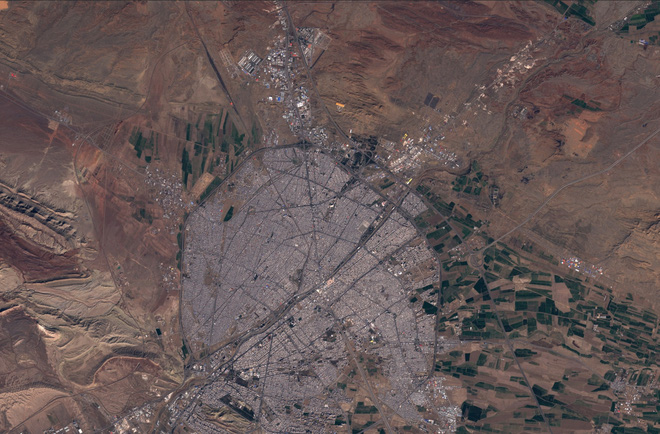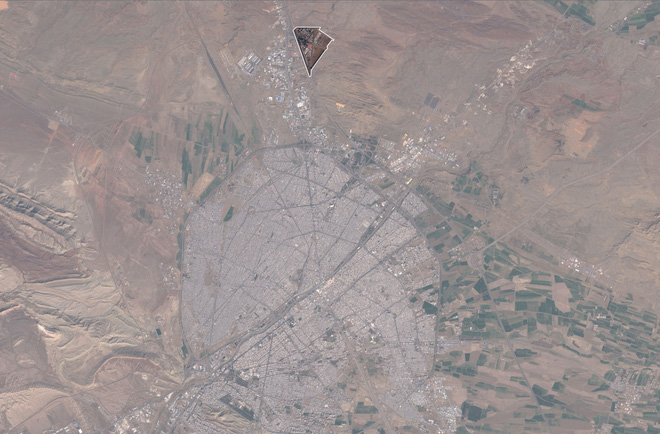The burial chamber of the deceased due to Covid-19 in Iran is large enough to be seen from space
The Washington Post reported that just two days after Iran announced the first case of a new strain of coronavirus (SARS-CoV-2), evidence of some "unusual" actions at the cemetery near the epidemic occurred. The disease appears.
At the Behesht-e Masoumeh complex in Qom city, about 100km south of Tehran, satellite imagery shows a plot of land in the cemetery being dug up from February 21. Virus outbreaks, soil grooves are also expanding. By the end of February 2020, two large trenches with a total length of 90m (equal to the length of a football field) were formed, so large that they could be observed from space satellites.


Cemetery area in Qom city
"Collective grave" for victims of pandemic Covid-19
According to an anonymous analyst, the ditch was used to bury victims killed by a new strain of virus in Qom City.
Iran, a country of 80 million people, is suffering from a devastating outbreak of Covid-19 that touches the country's leaders. The Iranian Ministry of Health said that 429 people died in the country today, more than 10,000 were infected, making it the third largest outbreak in the world after China and Italy. Among the dead included members of parliament, a former diplomat, even advisers to senior leaders. At least 26 civil servants were infected, including the vice president of the nation.



Image one of 2 trenches

Statistics show that 846 people were exposed to the virus in Qom city. The Iranian government has not released the death toll in this city, knowing only 1.2 million residents live there. But according to the Washington Post, videos, satellite images and data from the northern cemetery of the city show that the actual number of people infected by the virus may be larger than imagined.
An image analyst at technology firm Maxar Technologies (Colorado, USA) said the size and speed of excavation in Qom did not match the common burial ritual in this area. Some viral videos on social media show the tombs lined up in Behesht-e Masoumeh, and that it is for victims who died of the new strain of the virus.

The expert, who spoke on condition of anonymity because of his work sensitivity, also showed photos of the presence of white lime in large quantities, which could be used to control the decomposition process and the smell emitted from the corpse. . The Iranian Ministry of Health itself in recent weeks also confirmed the use of white lime when burial victims of the pandemic.
The graves lasted to the end
In a video posted on the BBC on March 3, the narrator described the image at the Behesht-e Masoumeh cemetery, when the men carried a coffin toward the ditch with endless stretching tombs. . At that time, Qom - like many other parts of Iran - was hit by an epidemic, causing thousands of infections and overwhelming the city's health system.
"This is a ward for virus victims," - the conductor said, turning the camera toward the ditch where staff in protective clothing stand by. "More than 80 people have been buried here." - this person emphasized the number, and said the video was shot on February 28.
In another video, the announcer said he was at Behesht-e Masoumeh cemetery on March 3 - 2 weeks after the first case in Iran appeared."An employee said they had to bury at least 250 people." - the speaker said.
"All of the graves are very new. They have only been in the last few days. And you can see, the gutter stretches to the very end."
You should read it
- Thanks to light, we know the history of the universe and the composition of distant celestial bodies
- 10 strange and interesting facts about the universe you may not have heard of
- Scientists conclude that the universe should have been wiped out since its formation
- How many planets are there in the universe?
- 14 interesting facts about the universe amaze you
- A mask asteroid flies across the Earth
- The world's largest virtual universe created by Chinese supercomputers
- Elements of the universe
May be interested
- The US was prosecuted after the virus attack on Iran
 on march 3, a german cyber security expert, ralph langner, said he believed the us and israel's mossad intelligence agency had used the stuxnet computer worm to attack iran's nuclear plant in the year. last.
on march 3, a german cyber security expert, ralph langner, said he believed the us and israel's mossad intelligence agency had used the stuxnet computer worm to attack iran's nuclear plant in the year. last. - Distributing spam with the theme of US-Iran war
 taking advantage of the tension in relations between the united states and iran, from the weekends, hackers have triggered the spam wave bringing topics of war between the two sides.
taking advantage of the tension in relations between the united states and iran, from the weekends, hackers have triggered the spam wave bringing topics of war between the two sides. - What happens to a user's Google account when they 'pass away'
 with the google accounts of the deceased, how will google handle all of their photo and video data?
with the google accounts of the deceased, how will google handle all of their photo and video data? - Point Nemo, the most isolated place on the planet, the burial ground of the International Space Station at the end of the mission
 nemo point, also known as inaccessible pole is the point lying on the ocean far from the mainland.
nemo point, also known as inaccessible pole is the point lying on the ocean far from the mainland. - The Easiest Ways to Find Large Files on Windows
 a quick and effective solution is to identify and delete large, space-consuming files that are hiding on your computer.
a quick and effective solution is to identify and delete large, space-consuming files that are hiding on your computer. - Should metal gears be used in space missions?
 the two new studies focus on using large quantities of metallic glass (bmg) as a material in making gears for space missions. metal glass is called bmg when used to produce products larger than 1mm (0.04 inches).
the two new studies focus on using large quantities of metallic glass (bmg) as a material in making gears for space missions. metal glass is called bmg when used to produce products larger than 1mm (0.04 inches). - How to transfer free space from one drive to another in Windows 10
 adding free space from drive to drive is the best way to make full use of hard drive space. excess space in large partition will not be wasted and the problem of lack of memory in smaller drive is also solved.
adding free space from drive to drive is the best way to make full use of hard drive space. excess space in large partition will not be wasted and the problem of lack of memory in smaller drive is also solved. - The world is at risk of virtual war
 security experts believe that the stuxnet virus, infiltrating some computers in iran's nuclear program, is part of a darker plan: to start an online war.
security experts believe that the stuxnet virus, infiltrating some computers in iran's nuclear program, is part of a darker plan: to start an online war. - Crazy for the first time, the map of the human intestine is established
 scientists at stanford medicine school of medicine (usa) used the latest advanced imaging techniques and examined eight regions of the small intestine and large intestine of nine deceased organ donors to map them. about the human intestine.
scientists at stanford medicine school of medicine (usa) used the latest advanced imaging techniques and examined eight regions of the small intestine and large intestine of nine deceased organ donors to map them. about the human intestine. - More than 60 prehistoric tombs are found at Burnt City
 a total of 66 graves have recently been unearthed in the city of burnt, a unesco world heritage site in southeastern iran.
a total of 66 graves have recently been unearthed in the city of burnt, a unesco world heritage site in southeastern iran.










 How did an oxygen exchanger through the outer membrane save lives of Covid-19 patients?
How did an oxygen exchanger through the outer membrane save lives of Covid-19 patients? Canada tests new vaccine against SARS-CoV-2 virus
Canada tests new vaccine against SARS-CoV-2 virus It took South Korea only 3 weeks to produce the Covid-19 test kit, and this is their secret weapon
It took South Korea only 3 weeks to produce the Covid-19 test kit, and this is their secret weapon Besides Covid - 19, it should not be subjective to other pathogenic viruses
Besides Covid - 19, it should not be subjective to other pathogenic viruses What is pandemic? When does WHO announce an epidemic as a pandemic?
What is pandemic? When does WHO announce an epidemic as a pandemic? A funny moment of Covid-19 season in Hue: Homemade robots from toy cars roam around providing relief for patients
A funny moment of Covid-19 season in Hue: Homemade robots from toy cars roam around providing relief for patients